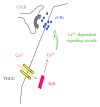Cellular signal mechanisms of reward-related plasticity in the hippocampus
- PMID: 23213575
- PMCID: PMC3504448
- DOI: 10.1155/2012/945373
Cellular signal mechanisms of reward-related plasticity in the hippocampus
Abstract
The hippocampus has the extraordinary capacity to process and store information. Consequently, there is an intense interest in the mechanisms that underline learning and memory. Synaptic plasticity has been hypothesized to be the neuronal substrate for learning. Ca(2+) and Ca(2+)-activated kinases control cellular processes of most forms of hippocampal synapse plasticity. In this paper, I aim to integrate our current understanding of Ca(2+)-mediated synaptic plasticity and metaplasticity in motivational and reward-related learning in the hippocampus. I will introduce two representative neuromodulators that are widely studied in reward-related learning (e.g., ghrelin and endocannabinoids) and show how they might contribute to hippocampal neuron activities and Ca(2+)-mediated signaling processes in synaptic plasticity. Additionally, I will discuss functional significance of these two systems and their signaling pathways for its relevance to maladaptive reward learning leading to addiction.
Figures





Similar articles
-
The cell biology of synaptic plasticity.Science. 2011 Nov 4;334(6056):623-8. doi: 10.1126/science.1209236. Science. 2011. PMID: 22053042 Free PMC article.
-
Elements of a neurobiological theory of the hippocampus: the role of activity-dependent synaptic plasticity in memory.Philos Trans R Soc Lond B Biol Sci. 2003 Apr 29;358(1432):773-86. doi: 10.1098/rstb.2002.1264. Philos Trans R Soc Lond B Biol Sci. 2003. PMID: 12744273 Free PMC article. Review.
-
Ageing, hippocampal synaptic activity and magnesium.Magnes Res. 2006 Sep;19(3):199-215. Magnes Res. 2006. PMID: 17172010 Review.
-
Cellular and molecular bases of memory: synaptic and neuronal plasticity.J Clin Neurophysiol. 1997 Jul;14(4):264-93. doi: 10.1097/00004691-199707000-00002. J Clin Neurophysiol. 1997. PMID: 9337139 Review.
-
[Synaptic plasticity in learning and memory].Usp Fiziol Nauk. 1999 Oct-Dec;30(4):3-13. Usp Fiziol Nauk. 1999. PMID: 10612184 Review. Russian.
Cited by
-
TET1-induced DNA demethylation in dentate gyrus is important for reward conditioning and reinforcement.Mol Neurobiol. 2022 Sep;59(9):5426-5442. doi: 10.1007/s12035-022-02917-0. Epub 2022 Jun 16. Mol Neurobiol. 2022. PMID: 35705787
-
Exploring the Connection Between BDNF/TrkB and AC/cAMP/PKA/CREB Signaling Pathways: Potential for Neuroprotection and Therapeutic Targets for Neurological Disorders.Mol Neurobiol. 2025 May 9. doi: 10.1007/s12035-025-05001-5. Online ahead of print. Mol Neurobiol. 2025. PMID: 40342191 Review.
-
Comprehensive analysis of genetic risk loci uncovers novel candidate genes and pathways in the comorbidity between depression and Alzheimer's disease.Transl Psychiatry. 2024 Jun 11;14(1):253. doi: 10.1038/s41398-024-02968-y. Transl Psychiatry. 2024. PMID: 38862462 Free PMC article.
-
Training on an Appetitive Trace-Conditioning Task Increases Adult Hippocampal Neurogenesis and the Expression of Arc, Erk and CREB Proteins in the Dorsal Hippocampus.Front Cell Neurosci. 2020 Apr 17;14:89. doi: 10.3389/fncel.2020.00089. eCollection 2020. Front Cell Neurosci. 2020. PMID: 32362814 Free PMC article.
-
Cocaine-induced locomotor sensitization in rats correlates with nucleus accumbens activity on manganese-enhanced MRI.NMR Biomed. 2015 Nov;28(11):1480-8. doi: 10.1002/nbm.3409. Epub 2015 Sep 28. NMR Biomed. 2015. PMID: 26411897 Free PMC article.
References
-
- Grace AA, Floresco SB, Goto Y, Lodge DJ. Regulation of firing of dopaminergic neurons and control of goal-directed behaviors. Trends in Neurosciences. 2007;30(5):220–227. - PubMed
-
- Di Marzo V, Matias I. Endocannabinoid control of food intake and energy balance. Nature Neuroscience. 2005;8(5):585–589. - PubMed
-
- Maldonado R, Valverde O, Berrendero F. Involvement of the endocannabinoid system in drug addiction. Trends in Neurosciences. 2006;29(4):225–232. - PubMed
-
- Diano S, Farr SA, Benoit SC, et al. Ghrelin controls hippocampal spine synapse density and memory performance. Nature Neuroscience. 2006;9(3):381–388. - PubMed
-
- Malik S, McGlone F, Bedrossian D, Dagher A. Ghrelin modulates brain activity in areas that control appetitive behavior. Cell Metabolism. 2008;7(5):400–409. - PubMed
Publication types
MeSH terms
Grants and funding
LinkOut - more resources
Full Text Sources
Miscellaneous

